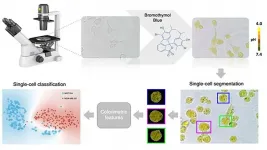(Press-News.org) Stem-cell-derived organoids that swell up with tears could shed light on the biology of crying and dry-eye disease, suggests a study publishing March 16 in the journal Cell Stem Cell. Although regenerative therapies using human tear-gland organoids will not be possible anytime soon, these researchers have demonstrated that the organoids can engraft, integrate, and produce mature tear products upon transplantation into mouse tear glands.
"We hope that scientists will use our model to identify new treatment options for patients with tear-gland disorders by either testing new drugs on a patient's organoids or expanding healthy cells and, one day, using them for transplantation," says senior study author Hans Clevers (@HansClevers) of the Hubrecht Institute.
The tear gland, or lacrimal gland, secretes the watery layer of the tear film and is essential for lubricating and protecting the eye. Dysfunction in tear production or secretion can lead to dry-eye disease or Sjögren's syndrome--a poorly understood autoimmune disease that causes dry eyes and dry mouth. Currently, treatment options for patients with disorders of the lacrimal gland include eye drops, tear-duct plugs, and surgery.
"What struck us is that at least 5% of the adult population is estimated to have dry-eye disease, which is most of the time related to a defect of tear production by the tear gland," says co-first study author Yorick Post of the Hubrecht Institute. "But treatment options are limited because there was no complete understanding of the biology and no reliable, long-term in vitro model to study the tear gland."
To overcome this hurdle, the researchers generated 3D mouse and human lacrimal-gland organoids derived from adult stem cells by adapting a protocol they previously used for other organs. The organoids could be expanded over multiple months and recapitulated structural, transcriptional, and functional features of the lacrimal-gland epithelium--tissue that secretes most of the tear fluid. Remarkably, the organoids swelled up like a balloon after being exposed to the neurotransmitter noradrenaline, which triggers tear secretion.
"The challenge was to get the organoids to cry, as this is a hallmark of the lacrimal gland," says co-first study author Marie Bannier-Hélaouët of the Hubrecht Institute. "We had to modify the cocktail of factors the organoids are grown in so that they would become the mature cells that we have in our tear glands and that are capable of crying."
The researchers leveraged the mouse organoids to explore the role of Pax6--the master control gene for eye development--in adult tear glands. By using CRISPR/Cas9 genome editing to delete Pax6, they discovered that the gene is an important contributor to the maturation of adult lacrimal-gland epithelial cells. These particular organoids could provide valuable insights into potential treatments for Sjögren's syndrome because PAX6 deficiency has been observed in the eye tissue of these patients.
Using single-cell mRNA sequencing, the researchers also examined poorly understood cellular features and origins of tear components in the lacrimal gland. Their single-cell atlas revealed new tear components and demonstrated that ductal and acinar cells in the human lacrimal gland secrete a different repertoire of tear components.
To test the potential of the organoids for regenerative medicine, the researchers then transplanted human organoid cells into mouse lacrimal glands. Two weeks later, the human organoid cells formed duct-like structures that remained in the lacrimal gland for at least two months. Engrafted organoids appeared to self-organize, and some cells were proliferating up to two months after transplantation. Moreover, the researchers detected tear proteins inside the ducts formed by the transplanted cells.
The beneficial effects of organoid transplantation will need to be validated in mouse models of dry eye disease. Future studies could also focus on modeling Sjögren's syndrome by incorporating immune cells into the organoids. "Patient-derived organoids open up new avenues to study lacrimal gland diseases in a personalized fashion," Clevers says. "But there is still a long way to go before these mini-organoids can be used for regenerative therapies."
INFORMATION:
This work was supported by a grant from the Leducq Foundation, a NWO-ZonW grant, an ERC Advanced Grant, a VENI grant from NWO-ZonMW, and the gravitation program CancerGenomiCs.nl from the Netherlands Organisation for Scientific Research (NWO). H.C. is the inventor on several patents related to organoid technology; his full disclosure is given at https://www.uu.nl/staff/JCClevers/.
Cell Stem Cell, Bannier-Hélaouët et al.: "Exploring the human lacrimal gland using organoids and single-cell sequencing" https://www.cell.com/cell-stem-cell/fulltext/S1934-5909(21)00075-8
Cell Stem Cell (@CellStemCell), published by Cell Press, is a monthly journal that publishes research reports describing novel results of unusual significance in all areas of stem cell research. Each issue also contains a wide variety of review and analysis articles covering topics relevant to stem cell research ranging from basic biological advances to ethical, policy, and funding issues. Visit: http://www.cell.com/cell-stem-cell. To receive Cell Press media alerts, contact press@cell.com.
Wealthier northeastern US states and Western European countries tended to have significantly lower mortality rates during second-wave COVID-19 infections, new research from the University of Sydney and Tsinghua University has shown. However, the pattern was not as general as expected, with notable exceptions to this trend in Sweden and Germany.
Researchers say mortality change could have several explanations:
European first-wave case counts were underestimated;
First-wave deaths disproportionately affected the elderly;
Second-wave infections tended to affect younger people;
With some ...
WASHINGTON, March 16, 2021 -- Cancerous cells exhibit several key differences from healthy cells that help identify them as dangerous. For instance, the pH -- the level of acidity -- within a cancerous cell is not the same as the pH within a healthy cell.
Researchers from the National University of Singapore developed a method of using machine learning to determine whether a single cell is cancerous by detecting its pH. They describe their work in the journal APL Bioengineering, from AIP Publishing.
"The ability to identify single cells has acquired a paramount importance in the field of precision and personalized medicine," ...
What The Study Did: The findings of this study suggest that, based on a sample from an otherwise healthy population, the overall number of SARS-CoV-2 infections in the U.S. may be substantially higher than estimates based on public health case reporting.
Authors: Robert L. Stout, Ph.D., of Clinical Reference Laboratory Inc. in Lenexa, Kansas, is the corresponding author.
To access the embargoed study: Visit our For The Media website at this link https://media.jamanetwork.com/
(doi:10.1001/jamanetworkopen.2021.1552)
Editor's Note: The article includes conflict of interest and funding/support disclosures. Please see the article for additional information, including other authors, author contributions and affiliations, ...
What The Study Did: Researchers examined nursing homes in communities with the highest COVID-19 prevalence to identify characteristics associated with resident infection rates.
Authors: Hye-Young Jung, Ph.D., of Weill Cornell Medical College in New York, is the corresponding author.
To access the embargoed study: Visit our For The Media website at this link https://media.jamanetwork.com/
(doi:10.1001/jamanetworkopen.2021.1555)
Editor's Note: The article includes funding/support disclosures. Please see the article for additional information, including ...
The first systematic study of its kind describes how human viruses including SARS-CoV-2 are better adapted to infecting certain types of tissues based on their ability to hijack cellular machinery and protein synthesis.
Carried out by researchers at the Centre for Genomic Regulation (CRG), the findings could help the design of more effective antiviral treatments, gene therapies and vaccines. The study is published today in the journal Cell Reports.
Living organisms make proteins inside their cells. Each protein consists of single units of amino acids which are stitched together according to instructions encoded within DNA. The basic units of these instructions are known as a codons, each of which corresponds ...
When scientists at the Institute of Science and Technology (IST) Austria looked at developing zebrafish embryos, they observed an abrupt and dramatic change: within just a few minutes, the solid-like embryonic tissue becomes fluid-like. What could cause this change and, what is its role in the further development of the embryo? In a multidisciplinary study published in the journal Cell, they found answers that could change how we look at key processes in development and disease, such as tumor metastasis.
To learn more about how a tiny bunch of cells develops into complex systems ...
CAMBRIDGE, MA -- In the past few years, several medications have been found to be contaminated with NDMA, a probable carcinogen. This chemical, which has also been found at Superfund sites and in some cases has spread to drinking water supplies, causes DNA damage that can lead to cancer.
MIT researchers have now discovered a mechanism that helps explain whether this damage will lead to cancer in mice: The key is the way cellular DNA repair systems respond. The team found that too little activity of one enzyme necessary for DNA repair leads to much higher cancer rates, while too much activity can produce tissue damage, especially in the liver, which can be fatal.
Activity ...
Several oceans' worth of ancient water may reside in minerals buried below Mars' surface, report researchers. The new study, based on observational data and modeling, shows that much of the red planet's initial water - up to 99% - was lost to irreversible crustal hydration, not escape to space. The findings help resolve the apparent contradictions between predicted atmospheric loss rates, the deuterium to hydrogen ratio (D/H) of present-day Mars and the geological estimates of how much water once covered the Martian surface. Ancient Mars was a wet planet - dry riverbeds and relic shorelines record a time when vast volumes of liquid water flowed across the surface. Today, ...
Birds breathe with greater efficiency than humans due to the structure of their lungs--looped airways that facilitate air flows that go in one direction--a team of researchers has found through a series of lab experiments and simulations.
The findings will appear Fri., March 19 in the journal Physical Review Letters (to be posted between 10 and 11 a.m. EDT).
The study, conducted by researchers at New York University and the New Jersey Institute of Technology, also points to smarter ways to pump fluids and control flows in applications such as respiratory ventilators.
"Unlike the air flows deep in the branches of our lungs, which oscillate back and forth as we breathe in and out, the flow moves in a single direction in ...
PHILADELPHIA - Imposter syndrome is a considerable mental health challenge to many throughout higher education. It is often associated with depression, anxiety, low self-esteem and self-sabotage and other traits. Researchers at the Sidney Kimmel Medical College at Thomas Jefferson University wanted to learn to what extent incoming medical students displayed characteristics of imposter syndrome, and found that up to 87% of an incoming class reported a high or very high degree of imposter syndrome.
"Distress and mental health needs are critical issues among medical ...


